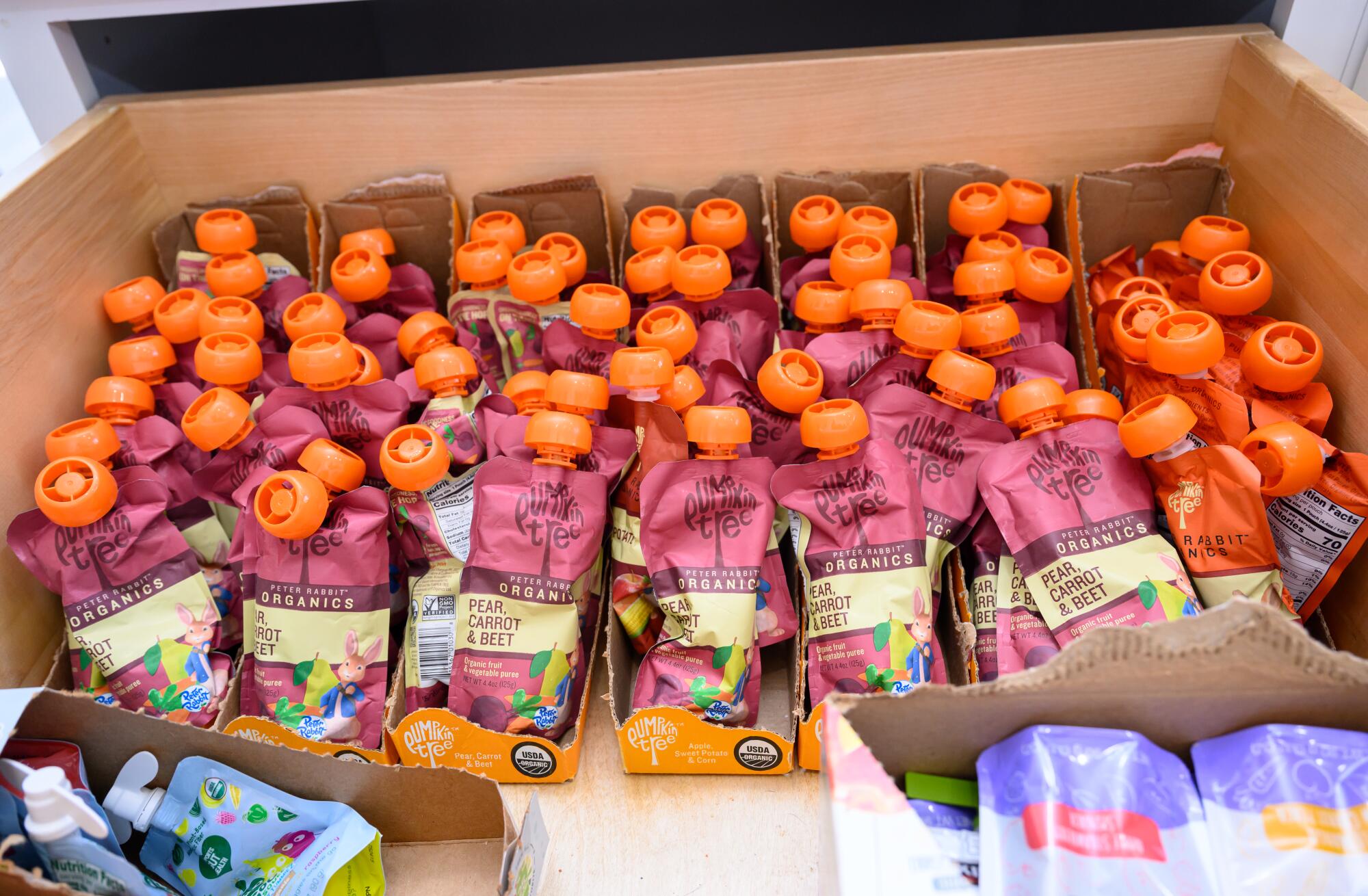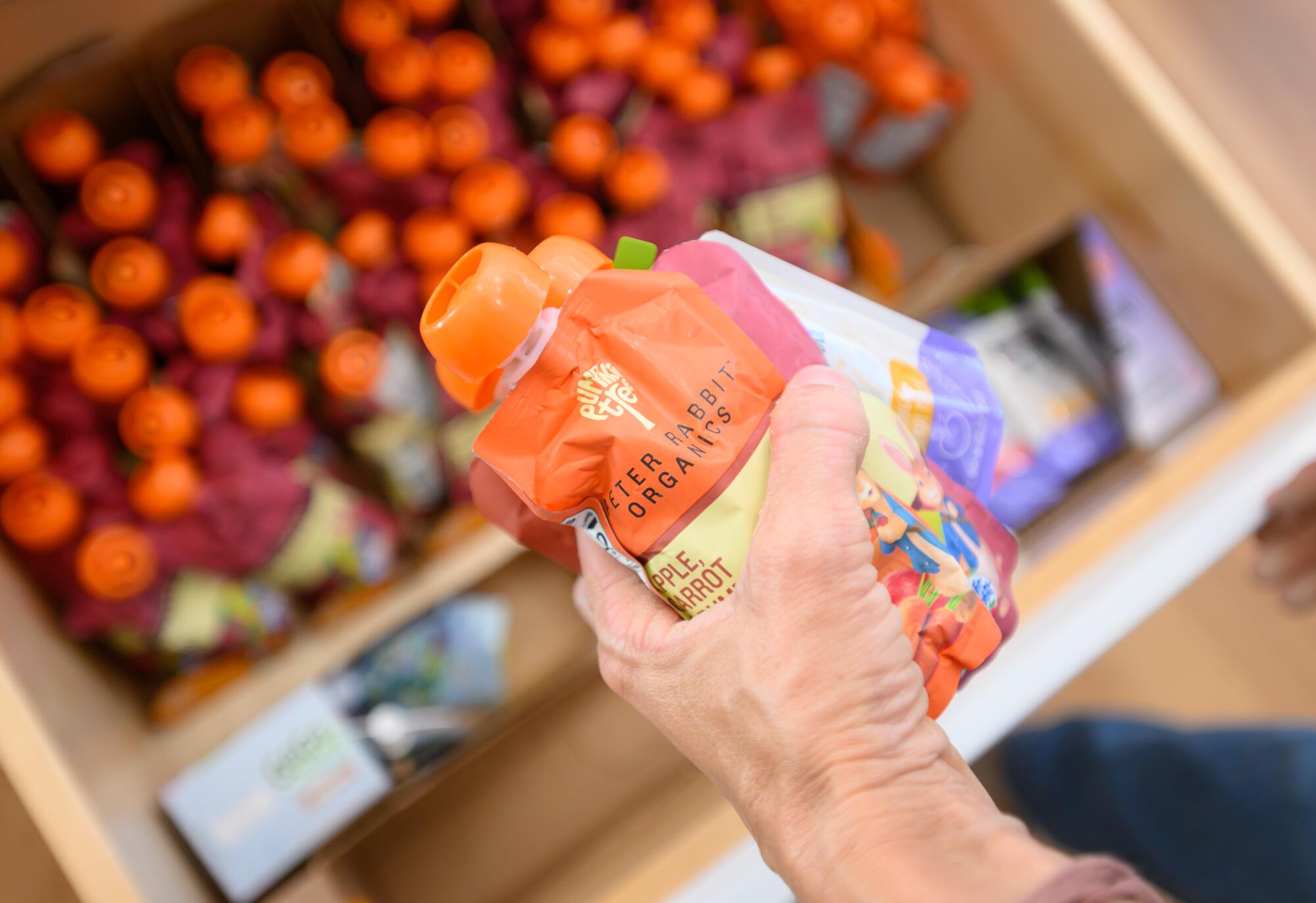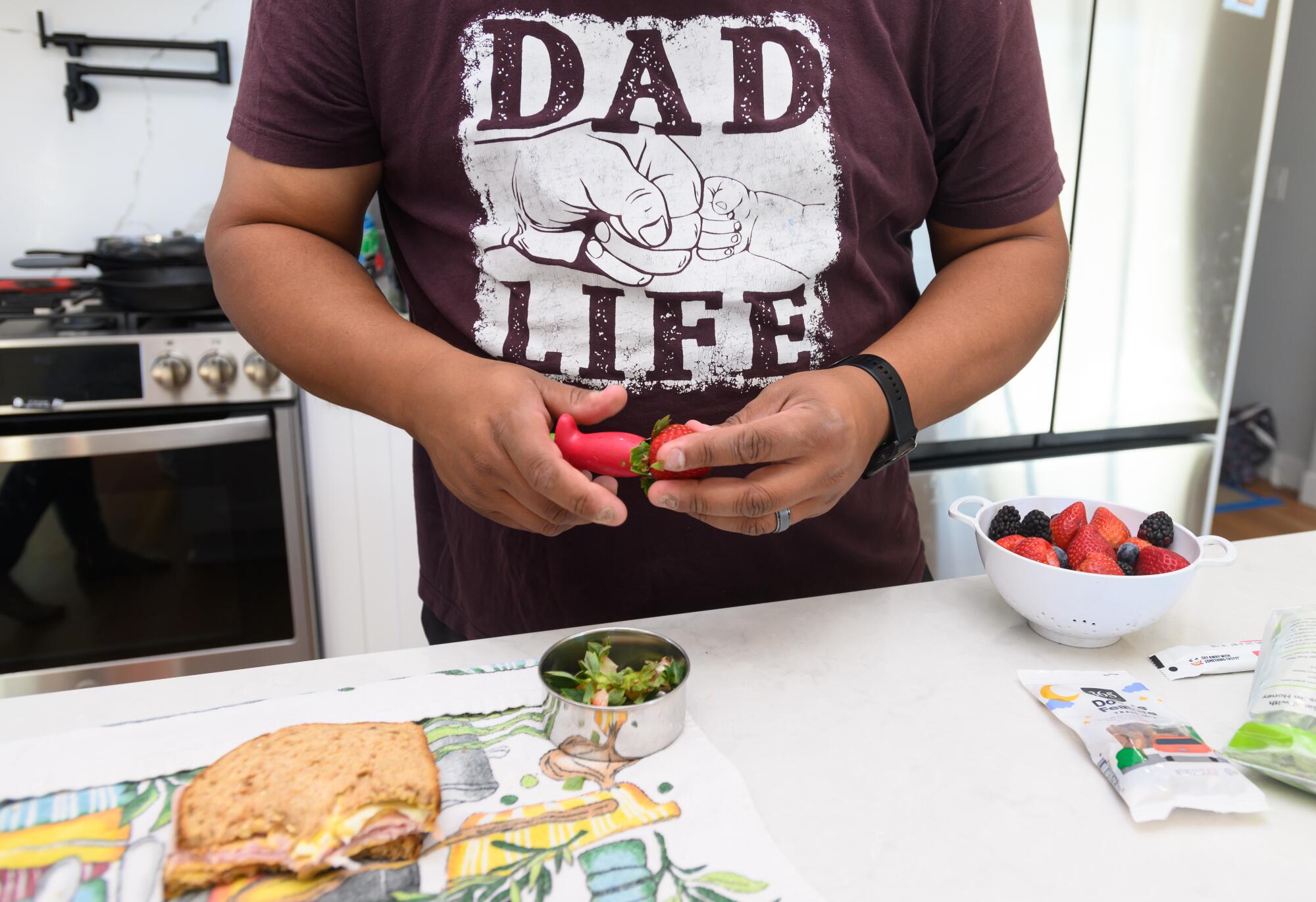
Every week, Caitlin Sciutto stops by Target and piles her cart with pureed food pouches for her 4-year-old and twin 18-month-old sons.
In goes a 24-pack of unsweetened applesauce. Then a 24-pack of the fruit and veggie blend. And finally, the yogurt pouches for her oldest son’s breakfast. “He’d eat six applesauce pouches a day if I let him,” Sciutto said.
For the record:
1:37 p.m. Oct. 23, 2024In an earlier version of this story, Caitlin Sciutto’s last name was misspelled as Scuttio.
Total monthly pouch budget: $200.
“They have such a choke hold on my family. I can’t imagine our grocery list without it at this point,” she said. “We are definitely a pouch family.”

And they aren’t alone. Sales of food pouches — soft bags with plastic spouts for easy consumption — have increased 900% since 2010, overtaking jarred purees as the predominant baby food on the market. Parents generally spoon-feed jars of pureed foods for a few months in the first year of life when introducing solids, but pouches marketed to parents of toddlers and older children have prolonged pureed food eating by years.
Though the occasional pouch can be part of a healthful diet, doctors and nutritionists are raising concerns that an overreliance on pouches can interfere with nutrition, long-term food preferences, dental hygiene and even speech and language development. And marketing practices can leave parents confused about what’s actually inside the packages.
“Pouches are highly processed foods,” said Dr. Steven Abrams, a professor of pediatrics at the University of Texas at Austin Dell Medical School. “They certainly serve as a quick snack, but we need to make sure that pouches don’t make up too much of a toddler’s diet. We want kids to learn to chew and eat foods like meat, and fruits and vegetables that are not processed.”

What’s inside varies greatly — some contain only fruit, while others have a mix of vegetables, grains, yogurt and even meat. Whereas many jarred foods contain a single ingredient like pureed peas or carrots, pouches are more often a blend that features a sweet fruit such as apple or pear as the primary ingredient.
A 2019 study found that infant and toddler food in pouches contained significantly more sugar per serving than foods available in other forms of packaging.
To be sure, there is not an epidemic of children who don’t know how to chew. But Dr. Mark Corkins, a pediatric gastroenterologist at the University of Tennessee Health Science Center who chairs the American Academy of Pediatrics committee on nutrition, said he sometimes sees children who are so reliant on the smooth, sweet taste of pouches that they have developed food and texture aversions and refuse to eat regular fruits or vegetables.
“In the long run we’re going to pay for it,” he said.
Engage with our community-funded journalism as we delve into child care, transitional kindergarten, health and other issues affecting children from birth through age 5.
Why are baby food pouches so popular?
Pouches are convenient: Unlike glass jars, they don’t shatter when dropped, and toddlers can suck down the slurry without help from a caregiver. However, most pouches are not recyclable.

“It is so dang hard to be a parent of young children in the U.S. Having [pouches] on an airplane, having them in the car — it is so convenient that I would never take that away from parents. I used pouches with my children,” said Bridget Young, an associate professor of pediatrics at the University of Rochester School of Medicine.
“The industry has gone from jars to pouches because it’s more cost-effective and convenient,” said Dr. Tanya Altmann, a pediatrician in Calabasas and author of the book “What to Feed Your Baby.” But it’s what’s inside that’s important, she said, and “not all pouches are created equal.”
As a tool, she said, pouches “can be a contributor to a family’s nutrition,” but not a prime source. Those without added sugars or salt may even have advantages over other processed snacks.
Heidi Martinez, a mother of three in the Bay Area city of Pittsburg, said she always buys the pouches with at least one vegetable. As her oldest son goes through “picky stages, I like that he is still getting some kale and beets,” she said. “I don’t know that they’re actually healthier but I feel better about it.”

At the age of 7, he eats two to three pouches a day.
Manufacturers appeal to parents by marketing a pouch as “all natural,” “organic” or containing vegetables.
But the advertising on the front of a pouch doesn’t necessarily reflect what’s inside. A green pouch advertised as “broccoli-pear” might turn out to be little more than pear puree. And a pouch labeled something like “turkey dinner,” Young said, “might be applesauce with a whisper of turkey.”
“And there’s nothing wrong with applesauce. But there is something wrong when you think you’re feeding your child turkey,” she said.
A new teaching credential is centering social and emotional development and playful learning in transitional kindergarten as it prepares the next wave of teachers.
Parents of picky eaters may be particularly vulnerable to this kind of marketing.
“It’s kind of the perfect storm, when the child is transitioning to solids and trying new foods,” said Fran Fleming-Milici, director of marketing initiatives at the Rudd Center for Food Policy and Health at the University of Connecticut. “You’re not sure of the nutrition that the child is getting.
Martinez said the real appeal, however, is the pouch itself. She considers pouches to be in the same category as a smoothie or yogurt, but in an easy to-go form.
The slippery slope of sweet, smooth purees
The early years of a child’s life are crucial for developing lifelong healthful eating habits. Babies are born with a preference for sweet foods, said Jill Castle, a pediatric dietitian in Massachusetts and author of the book “Kids Thrive at Every Size.” Typically, a child must be repeatedly introduced to various foods to get them used to different textures and flavors, such as the taste of vegetables.
It’s hard to beat the convenience of pouches — they’re easy to throw in a diaper bag or hand to a screaming toddler in the car. But experts warn relying on them too much could be a problem.
Fruit puree can disguise the taste of vegetables, reinforcing sweetness, Castle said.
If a child’s diet consists mostly of pouches, “when you actually give them chopped-up carrot and peas that roll around the plate, they’re not used to that at all” and may refuse it, said Daisy Coyle, who researches pouches at the George Institute for Global Health in Sydney.
Ideally, lumpy textures should be introduced as early as possible so the child can learn to use their tongue and jaw to manipulate and swallow food, a process that requires 30 different muscles to work together, said Susan Greenberg, a speech pathologist at Children’s Hospital Los Angeles. “We think it’s a natural process, but it’s like learning to walk,” she said.
A variety of textures is also crucial to developing a child’s long-term food preferences. “If you prolong purees and don’t introduce lumpy foods by 10 months, we have evidence that by 15 months and even 7 years, it influences food acceptance,” Greenberg said.
The full sensory experience of eating food is also important, she added — getting messy, using spoons, fingers and tiny fists to squish food and smear on a highchair and face.
Dentists also have concerns about what pouches mean for oral hygiene. Dr. Francisco Ramos-Gomez, director of the UCLA Center for Children’s Oral Health, said the way purees such as applesauce stick to the teeth is different from eating an actual apple, and it sits on a child’s teeth before being washed. This prolonged exposure increases the acidity of the mouth, erodes the teeth and causes cavities.
But it’s all a matter of moderation, Greenberg said. “Pouches are easy, and we live in a world that’s really busy these days. I think we can all agree that it’s not a bad thing. It just can’t replace the other things.”
Do toddlers really need their own special food?
By about 12 months old, typically, developing children do not need pureed food. “It was always a goal to get kids off of purees by 9 months and get them onto table food,” Castle said. “By 1 year, you’re sitting at the table with your family, and you’re eating what the whole family is eating.”
Toddlers and young children can eat most anything that an adult can eat, as long as it’s cut or prepared in a way that’s appropriate for their eating skills and doesn’t make it a choking hazard.
Kids in California struggle with more cavities than kids in most states, despite Medi-Cal efforts to fix dental care administrative hurdles and focus on prevention.
But brands have invented a whole new, lucrative category of toddler foods, from pouches and teething crackers to bars and puffs, Fleming-Milici said.
The major pouch manufacturers — including Gerber, Plum Organics and Happy Family Organics — did not respond to requests for comment from The Times.
In the last 12 months, American families have spent more than $466 million on baby food pouches, according to data from the market research firm NIQ.

The “Wild West” of the baby food aisle
As opposed to the tightly regulated U.S. infant formula sector, baby and toddler foods do not have their own special marketing and production rules; they are subject to the same requirements as adult foods.
“The baby food market is like the Wild West,” Castle said.
The World Health Organization came up with its own nonbinding set of standards for baby food, which included limits on fat, sugar and sodium. It also requires clear labeling of ingredients and prohibits the use of health, nutrition and marketing claims on the packaging.
A study by Coyle this year published in the journal Nutrients found 60% of the baby or toddler food products for sale at the top 10 grocery stores in the U.S. failed to meet the WHO nutritional recommendations. Almost all packages included at least one prohibited marketing claim, and some had as many as 11.
Many parents allow children more than double the TV and tablet time experts suggest. Families are turning to screens for learning and distraction, clashing with advice.
Earlier this year, the FDA recalled 3 million cinnamon applesauce pouches that contained extremely high levels of lead, after dozens of children across the United States were found to be suffering from lead poisoning. The FDA does not set heavy-metal limits or require baby food manufacturers to test for them.
“We really need to have some U.S.-based regulations, or decide we’re following the World Health Organization’s regulations. But there needs to be more tight control,” Castle said. “These are some of our youngest, most vulnerable members of our population.”
Instead of blaming families for overusing pouches, she said, new regulations, more healthful ingredients that target key nutrients, and more transparent advertising are needed. “Even just having more pouches that are predominantly veggie-based and less sweet would be a really positive change,” she said.
How to see through marketing pitches
To select the most healthful pouches, nutritionist Young recommends ignoring the advertising on the front of the package — including the name of the product.
Instead, flip to the back, where the ingredients are listed in order of how much is in the package, and look for pouches that list the veggies first. A pouch that lists apple first probably will be mostly applesauce.
Beth Saltz, a pediatric dietitian in Woodland Hills, said a general rule of thumb is to make sure that all of the ingredients listed could be sold in the grocery store. If the ingredients include things such as “organic tapioca starch” or “pea protein isolate,” or even natural coloring, you might reconsider.
“A little toddler does not need those,” she said.
This article is part of The Times’ early childhood education initiative, focusing on the learning and development of California children from birth to age 5. For more information about the initiative and its philanthropic funders, go to latimes.com/earlyed.
More to Read
Sign up for Essential California
The most important California stories and recommendations in your inbox every morning.
You may occasionally receive promotional content from the Los Angeles Times.














